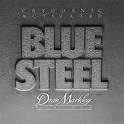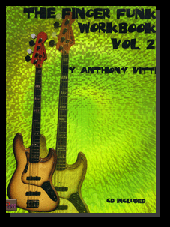

anyhonyvitti.com

The Finger Funk Workbook Vol. 2:
Those of you who are familiar with "The Finger Funk Workbook Vol. 1" will know what to expect from this book. If you don't own Vol. 1, it doesn't make a difference. Of course you should get it, but the two books are not linked in any kind of order. This book is just more of the same of what people have been asking me for. I had no idea how popular the first book would be when I put it out. I was just trying to offer something different from the many books that are already available from other publishers. Publishing these books myself gives me total control over the content. No one is looking over my shoulder telling me to make the material easier or harder. I'm putting out just what I want. I write this material for my students at Berklee College of Music. I run it by all levels of players before I decide to put any material in a book. This way I can be assured that the material is good and challenging.
I call this a "workbook", because it really is a book of exercises. The point is to give you a workout. Doing traditional exercises to build my chops always frustrated me. I put in a lot of time doing scales and arpeggios, but I got a lot more out of transcribing great players. I write these books the same way that I teach, by trying to write basslines that contain difficult fingerings or feels. All the grooves contain difficult fingerings either for the right or left hand, or it may be just the sheer tempo that makes them difficult. Make sure you take the time to play the grooves perfectly. Sometimes it appears on the surface that you have something down, but till you can do it consistently many times in a row, it's not down. The technique should not be your focus in the end. Your attention should be on the feel and sound of your playing.
I deal with hundreds of bass players at Berklee College and I see similar strengths and weaknesses in them. I try to bring out those weaknesses in this book. You may find that you have more trouble with some grooves than others. That will depend on your level of playing. Remember, I have thought long and hard about the fingerings in these grooves. None of the difficulty is by chance. Even if you can play something at the tempo in which it was recorded, you should try to play it faster. I recorded the examples at tempos where I thought they felt good. That's not to be taken as the fastest they should or could be played.
The grooves come from a combination of my own material and some of the greatest finger style funk players like Chuck Rainey, Tom Barney, Jaco Pastorius, Rocco Prestia, Gary Willis, Jeff Berlin, Marcus Miller, James Jamerson, Paul Jackson, Danny Wilson and many others I'm sure I've forgotten to mention. These are some of the players that have been the strongest influences for this style in my playing. I strongly suggest you do as much listening to them as possible to better yourself at this style. I tried to put the best aspects of these players into these grooves. This is a result of the many e-mails I have received asking for me to add it. I heard you, and here it is. The TAB has been removed in this new printing, but I added four new exercises to make up for it. There just wasn't enough people asking for the tab to justify all the extra pages in the book. I personally, would rather give you more material.
The one thing I hope you will get from this book is the importance of consistency. To me, having the ability to mute the strings well and hold the groove steady for a long period of time is priority one. Don't worry about the tempos. The tempos indicated on the pages are the recorded tempos. Practice the lines slowly enough so that you can play them many times in a row without making a mistake. You should try practicing the examples by looping four bar phrases. That will get you further than struggling with all sixteen. Good technique and execution at a slow tempo will get you a lot farther that playing fast and sloppy. Practice with a drum machine. That's why I included the patterns on the pages. Hopefully you can get together with a drummer and improvise on the grooves. I strongly suggest that you record yourself playing these grooves. It's amazing what you hear when you step back and listen to yourself. I try to record myself often, and then listen to it a few days later with fresh ears. Be critical of your playing and compare where you put the time and groove to where I put it on the disc. Speaking of the disc. I used my 1969 Custom Fender Jazz Bass to record all the examples. Fender Basses, there are no substitutes.
I would like to thank everyone who purchased this book as well as my others. Your positive support has enabled me to continue putting out challenging material for advanced players. More books will follow. I welcome your comments on this book or suggestions on other books, subjects or styles you would like to see me cover.
Sample
Back In Stock with 4 New Exercises!
Audio MP3$22.00
Anthony Vitti
Berklee College of Music







